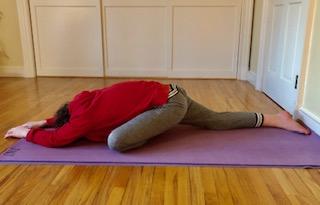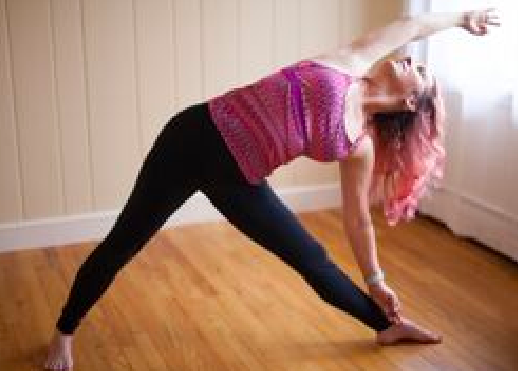Relephant:
Elephant’s Continually-updating Coronavirus Diary. ~ Waylon
How to Enjoy Life Amidst the Coronavirus Fear: Your Go-To Guide from Books to Podcasts & Wellness Practices.
What the Coronavirus is Teaching Me: 5 Lessons from Uncertain Times.
The Artist’s Stay-at-Home & Stay Sane Guide.
10 Simple Ways to Boost your Immunity without Leaving the House.
~
The higher my anxiety climbs during the corona crisis, the more imperative my yoga practice becomes.
Maybe you’ve felt it too.
I need the relief from interlacing my fingers behind my back in yoga mudra—forward folding just to hear that oh-so-good snap, crackle, and pop. Each inadvertent sigh that escapes my lips during a good side stretching pose reminds me why it is worthwhile to step on my mat.
Oh, to be rid of the stored tension and the rising fear of the unprecedented crisis we face!
Everyone feels anxious at some point whether it is a situational fear, panic over coronavirus, or a more acute anxiety disorder. In any case, anxiety can create the feeling of being out of control, having low self-esteem, persistent fear, panic, anger, or self-defeat—maybe all of the above.
Here are some anxiety-busting techniques to bring you calm amidst the corona chaos. They have gotten the most positive feedback over my eighteen years of teaching:
Feel like wringing your hands in frustration? Try a mudra instead. Mudra means seal, gesture, or mark. These symbolic gestures, often practiced with hands and fingers, aid in concentration and meditation. They facilitate the flow of energy in the subtle body, and enhance the journey within. Talk about healing hands! If the fingers were wires in an electrical circuit, the mudra would complete the energy loop.
Gyan mudra is probably the most well-known and is achieved by tucking the index fingers under the thumbs to invite calm, quiet mind, center, and ease. Prana mudra is recognizable as the peace symbol—fingers touching the thumb, ring, and pinkie fingers to boost focus and feel energized.
Want to scream? How about sounding off a mantra instead? Mantras are words or sounds repeated to aid in concentration and meditation. Here is an English mantra: inhale the word, “peace,” and then exhale the word “release.”
Holding your breath? Try breath extension, also called Pranayama, as an alternative. Use breathing techniques for self-regulation. We calm the breath to quiet the mind and central nervous system. First, inhale the belly out like a balloon, away from the spine. Then exhale the belly back into the spine.
You can also try Single Nostril Breath. Chandra, or Moon Breath, is a type of single nostril breathing for a cool, calming effect—the left nostril is associated with our body’s cooling energy. With your right thumb, close your right nostril, and inhale through your left nostril and then exhale through the right nostril. Repeat for one to three minutes to relieve anxiety, and quiet an unsettled mind. For this reason, it is recommended before bedtime.
Can’t see a way out of anxiety? Try visualization. Imagine filling the torso from bottom to top with breath every time you breathe in through your nose. Think of it drawing in sparkling, white light, vibrancy, and healing energy. Visualize emptying the torso from top to bottom and releasing any detritus you don’t need like it’s a gray mist from the mouth, every time you breathe out.
Anxious mind and tense muscles? Release the tension from the body. Make it a better vehicle for a peaceful mind with a yoga pose like Aka Asana.
These postures are useful for tension, but can also make you strong and flexible in the body as a by-product. Here are some of my favorites:
Tree Pose is used for balance, building bone density in the standing foot, hip opening, grounding, and centering (especially when feeling scattered). Visualize roots growing down through your feet into the center of the earth below you in one direction, and another line of energy traveling up your body toward the sun. With each exhale, imagine drawing down the prana from the sun into your being.
Sleeping pigeon is a forward fold that helps bring calm and includes a hip opener. Try stacking your forearms to make a cradle for your forehead, and take your awareness into your eyebrow center or third eye for calm awareness. Stay open to what comes up in the form of thought, sensation, or emotion.

Legs Up the Wall or Waterfall is a great way to give back to your hardworking legs after a strong standing practice, as well as to calm the nervous system. It stretches the hamstrings. This restorative pose gives the benefits of an inversion—fresh blood supply to the brain, improved circulation, and an immunity boost. It is energizing yet relaxing. This pose teaches us that there is always another way to approach the situation, person, or problem.
The Head-to-Knee pose is calming and relaxing and can help with anxiety, insomnia, headaches, and mild depression. Physically, the pose stretches the spine, shoulders, hamstrings, and groins, stimulates the liver and kidneys, and also improves digestion. One side is a hip opener, and the other is a back body stretch.
Child’s pose is yoga’s most important resting posture, and it is a nice way to gently stretch various parts of your body. It’s a chance to stop what you are doing, reassess your position, reconnect with your breath, and prepare yourself to move forward. It is also an aid for digestion.
Next time you feel anxious, notice your heart rate rising over the latest corona report, and strike back with some yogic tools from my mat to yours.
Relephant:











Read 8 comments and reply